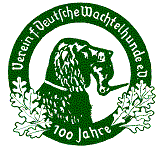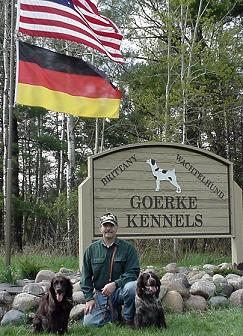Another Hunter's Perspective
By Gary Goerke

|
This article appeared in the August/September issue of Gun Dog magazine, gundogmag.com.
When I first heard of the Wachtelhund I was reading about the origin of the Brittany. Being a Bittany fan at heart I found out that some Brittanys were used in developing the Wachtelhund, a totally new breed to me. I looked for information on this breed but found only dead ends. Then one evening at Resi and Gerd Schreiber's German supper club in Pelican Lake, Wisconsin (I'm a Wisconsin native), I asked Gerd if he had ever heard of this breed. Gerd was born near Berlin, and he told me of the hunters and foresters in Germany that hunted and bred this aggressive, strong, yet affectionate dog. He referred me to Herbert Lang, a retired German judge from Bavaria, to find the Verein Deutsche Wachtelhund (VDW). Through this association I located my first male (Hecht St. Hubertus, call name "Pike") that I imported from Wolfgang Morgenstern from Barenfelds, south of Dresden near the Czech Republic in an area called the Erzgebirge. Wolfgang and his family have the oldest Wachtelhund kennel in all of Europe. The late Walter Morgenstern, Wolfgang's father, started St. Hubertus Kennel in 1921. Wolfgang's sons, Eberhard and Lutz, are now the third generation judging and breeding the dogs. The Morgensterns are credited with 30 litters to date. After importing Pike, my next step was to find a female. Wolfgang told me that a man in Canada just had a litter from his imported Wachtethund. Gerd, my family and I drove to Winnipeg to pick up our first female, Anabella Vom Lake Agazziz, from James Lockhart, a Canadian breeder who also had ties to the region near Dresden, Germany. He in turn introduced me to Roy Aafedt, who also purchased a pup from Jim's first litter, and Roy and I have been importing, breeding and hunting Wachtelhunds for the past seven years. I have imported a total of seven Wactelhunds for the breeding program that Roy and I have developed with the help of Eberhard and Lutz Morgenstern. To date I have bred my Pike eight times and produced a total of 61 pups. My breeding program includes females from Roy Aafedt, Chad Richardson, and my own imported female. Pups have been shipped all over North America, from Canada and Alaska to New York and California and in between. Pike also has been semen-collected a number of times, with the potential for 20 future breedings. I have found that Pike's sire is considered the perfect specimen of a braunschiemel Wachtelhund in Europe today. Thanks to the help of the Morgensterns, we will be importing more dogs in the near future. I sold a puppy from my first litter to Todd and Kimberly Geer of Grundy Center, Iowa, and from them I learned of the introduction of the Wachtelhund to North America. Kim had been brought up with the dogs because her father had learned of them in Germany where he was stationed. Kim's father purchased a pup from an officer in the USA who had imported a pair from Germany in the late 1950s or early '60s. After a few years they were in need of a new puppy and the family purchased one in 1971 from a doctor that bred Wachtelhunds in Oshkosh, Wisconsin. I have hunted Wachtelhunds in the north woods of Wisconsin on many different species, including ducks, grouse, rabbits, and predators. The Wachtelhund is a natural retriever in the water and on land, and they can weather the severity of northern Wisconsin's cold water and harsh winters. Blood trailing was introduced to me because of the Wachtelhund; I have trailed wounded whitetails with success as many as 17 hours after the shot. I now get calls from friends who need help with controlled recovery for wounded game. I have run bear during the training season in Wisconsin although the Wachtelhunds are dfferent than a hound and are not pack dogs, but solo hunters. They will yap (bark) on trail but I have yet to harvest a bear with a solo dog. I will continue this hunting as they have the ability and persistence to hold game at bay for the hunter. This breed can be disciplined to stay in close and work in the field or forest for the foot hunter, or can be trained like a hound to trail coon, cat, bear or boar. Roy and I have hunted the breed in the Dakotas, Montana, Nebraska and Iowa with great success on ducks, geese, grouse and pheasant. Hunting standing corn is very easily done with this breed (compared to my Brittanys) as they check back with you or they yap and let you know to "Get ready, partner!" Doug Ferry has hunted in Alaska with his Wachtelhund and loves its size because he can keep the weight down in his airplane while traveling to remote areas and yet still have an aggressive hunter. I believe the Wachtelhund can and will be used for many diverse hunting situations throughout North America. The Wachtelhund has a great potential for a fall turkey dog that can alert a hunter by yapping while flushing the birds but then return to the hunter for good concealment. The Wachtelhund can adapt to different hunting scenarios easily because of its high intelligence. They make eye contact often with you and can feel changes in emotion levels, so their training is very similar to spaniels. Too harsh treatment during training sessions can ruin a good dog but their willingness to learn is great. The Wachtelhund is not a good kennel dog; it does best with the hunter in the home as a family companion. The dog does best when frequently hunted and is not for just the Sunday hunter--a prospective buyer should be serious about training and development of the dog. If you are shopping for a hunting dog, the Wachtelhund is one to consider if you are not in need of a specialized breed. The dog is not lacking in style or elegance but will put plenty of game on your table. Gun Dog columnist Dave Duffey owns a Wachtelhund from my third litter. Dave is developing Corky's hunting abilities now. Watch for his in-depth article on the Wachtelhund in an upcoming issue. This article appeared in the August/September issue of Gun Dog magazine, gundogmag.com. |
|
For more information or to find a Wachtelhund to purchase, visit wachtelhund.com or contact: John Oberhaus joseph9970@fbcom.net 563-210-8273 |

